"The practice of yoga, in fact, reveals that the body is in no way separate from the psychospiritual forces that animate it." 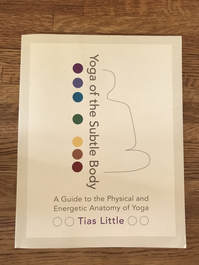
This is the book I've been waiting for.
Have you ever read a book where you didn't even know what you didn't know until you read it? Reading this book, Yoga of the Subtle Body, was like finding the last few puzzle pieces I'd been looking for...BUT, instead of completing my puzzle, it has "springboarded" me to go even deeper into my yoga practice. The introduction starts with the question “What is the subtle body?” which is an excellent question. Indeed, what IS the subtle body?! He describes it as the fine, delicate, infinitesimally small, all-pervading psycho-spiritual force that transcends scientific rationale. (No wonder I had a hard time understanding it pre-book :) ) The neat thing about this book is that Tias unravels the complex and intricate aspects of the subtle body, while using our modern understanding of anatomy and physiology to anchor the teachings. There's more though. He weaves together wisdom from different practices, ages and disciplines including: classic Indian mythology, the chakra and nadis systems, the structural body, traditional Chinese medicine, craniosacral therapy and reflexology. He does a fantastic (and probably very hard) job at distilling and uniting all of this wisdom in one place.
Throughout the book, Tias includes gentle yoga, pranyama and meditation exercises that apply the mind-body principles he shares. These practices are not to be skimmed over, but to be slowly and deeply experienced, allowing the wisdom to absorb. He doesn't talk about asana as mechanical poses, but takes the reader much, much deeper into the felt and internal experience of the pose, and educates the reader on the vibrational, pranic and subtle aspects of the pose.
His writing is poetic and embodied - making this manual even more coveted in my opinion. As I was reading I could feel my inner body responding to his words. For example, "soak your awareness into your heartbeat the way rainwater soaks the ground after a storm," (page 185). It's in his use of language that he achieves his intention of inspiring the reader to look at their yoga practice in a new way. “I believe that ultimately it is impossible to articulate the yogic experience in words. By articulating the body-mind connection through analogy and image (such as lifting the brain stem upward like the hood of a cobra), a direct experience of the sublte body becomes more palpabe. Metaphorical thinking allows for greater flexibility, imagination, and openness, all of which are integral to the mind in meditation.” (page 2)
I found this book very applicable to grief, because grief is a holistic experience that permeates all aspects of our being. It's impossible to outline all the ways this book could be supportive of grief, because everyone's experience is individual - but I can guarantee that there will be something that resonates with your experience. He writes about prana, the immeasurable source of life itself, as being impacted by the powerful effects of emotion (page 3). He writes about the gut and emotional distress. He describe the energy channels and meridians of the legs as being essential for grounding, which can be really helpful in the wake of loss and upheaval. One part that I found really interesting is the hand-lung-heart connection (see photo below).
This review was difficult to write because of the amount of wisdom this book imparts, however, it's suffice to say that I thoroughly enjoyed reading it. So much so, that I'm reading it a second time. No, reading is the wrong word. I'm experiencing it in my body as I go through it again. I plan to take a really, really long time, and (quite literally) take-in, everything I can.
Resources for further exploration...
You can pick up a copy of this book on Amazon Canada by clicking the link below, or visiting your favourite bookstore.
While I was reading this book, I was concurrently doing a series on Gaia called Shapeshift: Exploring Movement & Emotions with Ashleigh Sergeant. She is a student of Tias Little's and offers a great 7 week series that guides you through some of the practices outlined in the book. It was really interesting to combine the two. Highly recommend.
I'd also recommend Tias Little's website - https://www.prajnayoga.net
You can also find him on YouTube. Just search his name in the YouTube search bar, and you'll find lots. READING GIVES US SOME PLACE TO GO WHEN WE HAVE TO STAY WHERE WE ARE. - MASON COOLEY
Namaste,
Sandy
0 Comments
It’s been almost a year since I wrote on this blog. For those who have subscribed to receive notifications of updates, I apologize for my absence.
I’ve lacked focus here. I’ve struggled with what to write. The topics I want to write about - yoga and grief - are so huge, that it’s overwhelming to distill it down to one coherent piece that is educational, informative and personal. Over the past few years I’ve pursued more education and training in yoga, grief and end-of-life, and it seems that the more I learn, the harder it is to write about. One of my great Uncle’s who was a famous chemist once said, “The more I learn, the less I know.” I always wondered what he meant by that. Now I know. I sent out a SOS to my email list, requesting feedback on what people would like to read about. I got one reply – from my friend’s husband – who simply wrote, “I would like to know why you teach what you do.” It’s taken me a while to condense that suggestion into a direction and plan. Why do I teach what I do? I like where this could go. It appeals to me to take it right back to the beginning. Right down to the studs. The crux of why I thought yoga would be a good support for grief, and why I created the class I did. I’m excited about this. It’s given me a new way to communicate how yoga can support grief – from a more personal vantage point – and yet, hopefully universally enough that people can relate. Stay tuned… …I know I’ve said that before, but really…this time I mean it. xoxo Sandy There is a difference between a broken heart and a heart broken open. The broken heart is real but leads to a shutting down on life. The heart broken open creates the possibility for light to filter in. In that open space, there is room for compassion and tenderness to grow. In the end, choice helps to shape your experience. Choose to let your heart be broken open and see what remains to grow. - Ashley Davis Bush  I resonate with the work of Ashley Davis Bush and find her to be so affirming and loving in sharing her wisdom. When I saw the quote written above on her Facebook page and it made me think of all the heart opening practices there are in yoga. Slowly and gently yoga invites you to notice your heart. To breathe into it, and to create space in it. Enough space to hold all the hurt and all the love simultaneously - perhaps this is what being broken open means. Connecting with the heart's brokenness and openness creates compassion and understanding, and from there, choice. Choice to treat yourself compassionately, choice to make decisions that are life giving and self supportive. There can be wisdom and guidance in a heart broken open. Below is a short heart opening sequence. As you move through this practice be open to how your heart is communicating with your mind and body. Notice what thoughts present themselves to your mind. Notice your emotional reactions to them. Notice the subtle (or not so subtle!) sensations in the body. This practice isn't about solving or changing anything. It's simply about connecting and opening to the wisdom and awareness that can reside in a heart broken open. Trust yourself. 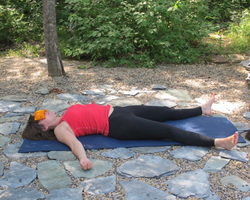 Start in savasana. This is my favourite way to start class. Use this time as a time to transition from living your day outside yourself (as is often the case with jobs, families etc) to a "yoga space." A time of awareness and connection with yourself. Allow your body to settle, and bring your awareness to what you are experiencing on the inside. Take this time to allow your mind to settle on the breath, noticing its rhythmic flow, constancy, and availability. There is no rush. Take time to slow down. Take time to practice being open to and with your heart. Bend your knees and roll onto one side. Resting there for a moment. Pressing up to sitting and setting up for a deeper heart opening pose. For this pose you will need two blankets, folded so it resembles a long skinny rectangle. Set yourself up so that one folded blanket is placed towards the head of your mat, around where your shoulder blades will be. Have the other folded blanket to place under the knees. 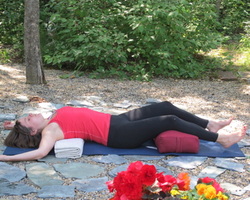 You will lay back on the blanket so it touches the shoulder blades. The shoulders must be above the blanket, so the shoulders can release towards the floor. Notice in the photo how my arms can easily fit above the blanket and the blanket is placed below the arm pits. **If the shoulders are resting on the blanket, it will not allow your heart to open. Place support under the head if your chin is lifting up, or if there is tension in the neck or throat. Allow your upper back and knees to gently cascade over the blankets...hence the name, waterfall pose; Imagine water as it flows over rocks in a stream, smoothly and softly. Breathe into your heart. Inhale and swirl the breath around your heart with the intention of having the breath nurture and explore the heart. Exhale and relax, sink, soften. Inhale and swirl, nurture, open, explore. Exhale soften. To move out of this pose, roll over to one side and press up to sitting. 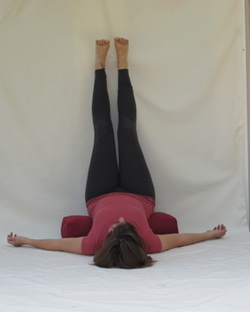 Next, move yourself to a wall. Have your folded blanket ready to use, or a bolster. The easiest way to get into legs up the wall pose is to sit beside the wall right hip and thigh is parallel to the wall. Turn to lay down on your back and swing your legs up the wall. Spend a few moments here, allowing your body to adjust to this position. There is no hurry. Slow down. Bend your knees and place your feet on the wall. Lift your hips up off the floor and slide your blanket or bolster underneath your hips. You want to feel stable here so adjust the props as needed. Roll your shoulders together behind your back and press them into the floor so your breast bone lifts towards your chin and your chest and heart is open. Breathe into the openness of your heart - the center of your chest. As you inhale expand the breath to both shoulders. Exhale and soften. With each in-breath expand the breath further: from the center of your heart to both shoulders and eventually down the arms and into the hands. When you are ready to come down: place the feet on the wall and lift the hips. Remove the bolster or blanket and roll down one vertebrae at at time. This can be a really nice release for the back so move slowly and care-fully. Once your hips are back on the floor, rest. Staying in legs up the wall is a nice way to end the practice. Or, stretch out, lay flat (as in the start) and rest. For the first 10-20 breaths of savasana focus on breathing light into the heart. You can imagine a warm glow or a candle flame. As you inhale, imagine that light growing brighter. As you exhale maintain a sense of a light inner body. Inhale and grow the light brighter. Exhale and maintain. "The heart broken open creates the possibility for light to filter in." - Ashley Davis Bush. Namaste, Sandy 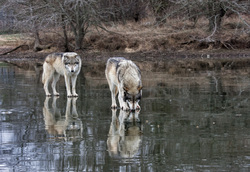 Taking wisdom from the Cherokee culture today...this is a wonderful story about the importance of making space for ALL of your experiences; whether you perceive them as positive or negative. This rendition of the story I got from ServiceSpace's weekly email called InnerNet Weekly (February 5th 2013) and it's called "Beyond the Conflict of Inner Forces." An old Cherokee is teaching his grandson about life: “A fight is going on inside me,” he said to the boy.”It is a terrible fight and it is between two wolves. One is evil – he is anger, envy, sorrow, regret, greed, arrogance, self-pity, guilt, resentment, inferiority, lies, false pride, superiority, and ego.” He continued, “The other is good – he is joy, peace, love, hope, serenity, humility, kindness, benevolence, empathy, generosity, truth, compassion, and faith. The same fight is going on inside you – and inside every other person, too.” The grandson thought about it for a minute and then asked his grandfather: “Which wolf will win?” You might heard the story ends like this: The old Cherokee simply replied, “The one you feed.” In the Cherokee world, however, the story ends this way: The old Cherokee simply replied, “If you feed them right, they both win.” and the story goes on: “You see, if I only choose to feed the white wolf, the black one will be hiding around every corner waiting for me to become distracted or weak and jump to get the attention he craves. He will always be angry and always fighting the white wolf. But if I acknowledge him, he is happy and the white wolf is happy and we all win. For the black wolf has many qualities – tenacity, courage, fearlessness, strong-willed and great strategic thinking – that I have need of at times and that the white wolf lacks. But the white wolf has compassion, caring, strength and the ability to recognize what is in the best interest of all. "You see, son, the white wolf needs the black wolf at his side. To feed only one would starve the other and they will become uncontrollable. To feed and care for both means they will serve you well and do nothing that is not a part of something greater, something good, something of life. Feed them both and there will be no more internal struggle for your attention. And when there is no battle inside, you can listen to the voices of deeper knowing that will guide you in choosing what is right in every circumstance. Peace, my son, is the Cherokee mission in life. A man or a woman who has peace inside has everything. A man or a woman who is pulled apart by the war inside him or her has nothing. "How you choose to interact with the opposing forces within you will determine your life. Starve one or the other or guide them both.” Here is a moving rendition of Amazing Grace. It's the Cherokee version, done by Walela. Best experienced with the volume turned up, and headphones on. From my heart to yours, Sandy  I can’t be the only person on this planet who has struggled with holding the pain of grief and “thanks-giving” at the same time. Just today, I heard an ad on the radio outlining the things we should be grateful for. That one word, “should,” got my back up. Gratitude has become a buzz word, and I’ve often wondered how many people (myself included) really understand what gratitude is? In our busy distracted world I wonder if people really do feel and experience a deep sense of thankfulness and appreciation instead of just saying they do? Especially in the face of loss and grief. Back in October 2006, I attended our annual family thanksgiving dinner fill with dread. All 40 of us circle around the room and state what we are thankful for. That year, I had nothing. Cam died 4 months prior, I was overcome by the largeness of my loss. As CS Lewis wrote in A Grief Observed, about his wife’s death, “her absence is like the sky, spread over everything.” There was a lot I should have said, and even could have said, but I didn’t. I could have said, “I am grateful for my health,” but instead I agonized over, “Why wasn’t he healthy?” I could have said, “I’m thankful for having him in my life,” which simply reinforced how much I lost and how much I still wanted him in my life. I could have said, “I’m grateful for my family,” but the only person I was looking for in that crowded room was him. Gratefulness felt trite. Empty. Impossible. Earlier that October day I had been sitting outside in the fall sunshine. I closed my eyes and absorbed the warmth of the sun. I could smell the crispness of fall in the air. I heard the flap of a bird’s wings as it flew overhead and stared in awe at the mere fact I just heard a bird flying. I felt something in those experiences. I absorbed, smelt, heard, and felt awe. But, I can’t say I took the time to appreciate them. And yet, looking back, these glimpses of experiences that were so small brought large amounts relief and reprieve. Now I see that what I needed at the time was to not only understand the power of gratitude but to shift my expectations of it. To forget what the world thinks I SHOULD be grateful for and find things that move me to a natural state of deep appreciation and kindness…and beyond that, recognize that state as gratitude itself. In wrestling with this over the years, I have learnt some valuable lessons about how to make gratitude a more accessible experience even in the face of grief. 1. Be flexible with your expectations around gratitude. Gratitude is malleable, and your perception of gratitude will change depending on life circumstances. There may be times in your life when your gratefulness spans life-times and relationships, and there may be other times when you are grateful to get through a moment. For example, when you are healthy, it’s easy to say, “I’m grateful for good health.” After a life threatening diagnosis, your expectation of gratitude may change to being grateful for good lab results, or a good report from a surgeon. Your benchmark of gratitude has shifted and this flexibility allows you to find gratitude despite challenging situations. 2. Slow down enough to notice the small things. Think of gratitude as a practice of mindfulness. On my daily dog walk I could go over projects, to do lists, mentally solve all my problems and do all my thinking, but instead of being “mind full” I try to be mindful. I try to get out of my head and into my body. I engage my senses and take the time to notice the beauty around me; to see the slanted light shining through a grove of trees or the red fall leaves against a bright blue sky, hear the crunch of snow under my boot on an otherwise silent morning, smell the pine tree as I walk under it, the relief and release I feel after in my chest and shoulders after a deep sigh. Instead of these small things going un-noticed, they become an intentional exercise in appreciation. Thich Nhat Hanh says, "People usually consider walking on water or in thin air a miracle. But I think the real miracle is not to walk either on water or in thin air, but to walk on earth. Every day we are engaged in a miracle which we don't even recognize: a blue sky, white clouds, green leaves, the black, curious eyes of a child - our own two eyes. All is a miracle." 3. Let it sink in. Take the small things and the beautiful things, and make them big things. Be open to feeling the shift in perception when something sparks that fire of appreciation and relief within you. That spark is what we are grateful for – it’s a feeling, a visceral response that brings us much-needed reprieve… 4. Understand that gratefulness is not about denial of loss and grief. Alternatively, we become more aware of the fullness of life – the beauty and the pain. Holding both means full engagement of the heart, full compassion, full living. Zora Neale Hurston captured both profound life and profound gratitude when she said, “I have been in Sorrow's kitchen and licked out all the pots. Then I have stood on the peaky mountain wrapped in rainbows, with a harp and sword in my hands.” This thanksgiving, take time to slow down, and notice the small things. Gratitude helps to build courage, resilience, feelings of connection and well-being and sometimes we have to be intentional about finding these moments and letting them grace us. Warmly, Sandy On the topic of Gratitude, I have found these sites invaluable: http://www.huffingtonpost.com/ashley-davis-bush/happiness-tips_b_3790758.html http://www.ashleydavisbush.com/general/its-all-about-beauty/ http://www.gratefulness.org/index.htm http://www.youtube.com/watch?v=tDVF4x8h-8I 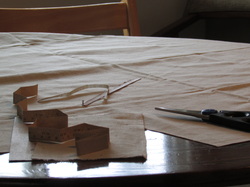 The hardest part of making my prayer flag was deciding which prayer to use! I had a number in the running, and finally decided on one that I've used on a regular basis in my own life. It's the Zen Night Chant from the Upaya Zen Center: "Life and death are of supreme importance. Time passes swifty and opportunity is lost. Let us awaken Awaken... Do not squander your life." I relate to this prayer both in my own life, and as a wish for the people of the world. It speaks to what I have learned about how I want to live and love, understanding that life hangs on by a thread and things can change in an instant. It speaks to the power of grief to awaken the fires of truth and compassion within, recognizing that hearts break...break open...leaving an opportunity for growth and healing. It just felt right to use this prayer - it felt easy to infuse the flag with all the depth and wisdom I read between the lines. And so the creating began....  First, I had to buy a vintage train case to hold all my supplies....Ok, maybe not an essential step, but a FUN step. I wanted something that I could hold everything in easily, and something that was easy to transport. Voila. It's perfect. And cute. 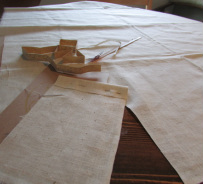 Next I chose the material. Traditionally prayer flags are bright, but I felt drawn to more earthy colors, so I chose a light beige as the base color, with brighter accents. I cut a piece of material 5" x 11" and then folded the top edge over 2" ish and pinned it. This will become the casing where the string will be threaded through to tie the flag to a tree. Then I used a simple running stitch to close the top casing. It doesn't look as professional as a if were sewn by a machine, but I kind of like the "homemade" feel to it. Considering this, I also did not hem the sides and bottom of the flag, but I suppose you could if you had a sewing machine. I left the bottom edge of my flag slightly frayed - it made it look a little more used or natural or...something.... 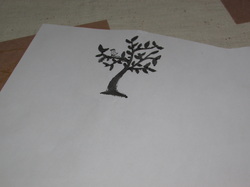 For the accents, I cut two smaller squares of a sheer aqua blue material, to be glued onto the flag as an inset; one to write my prayer on, and the other to draw* a tree. * By "draw" I mean that I printed a drawing of a tree from the internet and used it as a template to trace onto the material. I may be creative, but I'm no artist. The tree is symbolic of a verse from a poem that I love by E.E. Cummings called I Carry Your Heart: "...here is the deepest secret nobody knows (here is the root of the root and the bud of the bud and the sky of the sky of a tree called life;which grows higher than soul can hope or mind can hide) and this is the wonder that's keeping the stars apart..." 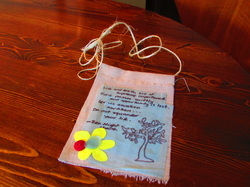 And, finally I put it all together. I glued on my insets with the prayer and tree. To brighten it up, I decided to cut out a yellow flower, and to sew on a red button. Yellow because it is a color I find cheerful, and a red because it feels primal and instinctual. Lastly, I threaded a piece of twine through the top casing and my flag is officially complete! Next weekend is our trip to Vision Quest Ridge in Nordegg, Alberta. I'm packing this flag and will hike it up to an ancient vision quest site where I will tie it in a tree to spread my prayer with the wind. Next time you see it, it will be blowing in the wind.
Until then... Be well, Sandy When I was asked to write this guest blog, I was honored and am still very honored. As a dance/movement therapist, I was excited to share from this perspective and advocate for the body's role in grief, mourning, and healing and then I let myself become caught up in expectations about having to write from this perspective. I thought I had to write the most poetic piece but through that journey the topic of this blog blossomed: permission. A topic that may seem so benign on the outside but in reality is important. Sometimes it is the journey that we find what is already naturally onside of us. To live authentically and in the continued interest of self disclosure, my intention is to not write the perfect post but rather speak from the heart and an embodied place in support of my own journey and your journey. The world may place many expectations on how we move through grief and bereavement. People may attempt to push someone to move on or present ideas meant to be helpful with well meaning intentions. Action is being advocated for and as a consequence a place to explore and move through one's own process is not given the space and freedom to develop. Everyone has their own way of expressing and journeying through their grief. We may feel it in our hearts, our stomachs, or our limbs. We may express our feelings through stillness, spoken words, written words, art, music, or dance. There is wisdom is what messages the body conveys about our grief and how we choose to convey our inner process. Trusting one's own process can be freeing. Our grief and healing process is our own and it is okay to go through one's own journey! Yes, I am saying that everyone has permission to be as you are in your process.I hereby give all of you permission to grieve, mourn, move, heal, and be who you are in your own process. Below I have included a blank form that you may find useful. Peace be with all of you. Kimberlee Bow, MA, R-DMT Kimberlee Bow obtained her Master’s in Somatic Counseling Psychology with a concentration in Dance/Movement Therapy. She obtained her R-DMT or Registered Dance/ Movement Therapist credentials by meeting the high standards that are required of the field. Dance/Movement Therapy is based on empirically supported evidence that the body, mind, and spirit are interconnected. A dance/movement therapist therefore uses movement in a psychotherapeutic manner to encourage emotional, cognitive, psychical, and social integration and growth. Dance/Movement Therapy is suited for individuals, groups, family, and couples and can be used with multiple different populations in many mental health or medical health settings. For more information please visit the American Dance Therapy Website. There, one can find more information about Dance/Movement Therapy, the organization, great resources, and access to a list of Dance/Movement Therapists in your area.
Kimberlee Bow works in Colorado in a private practice with children and families. Additionally, she brings Dance/Movement Therapy to elder groups, veterans, at-risk youth, support groups, intergenerational groups, and continues to expand her work. Her website, www.kimberleebow.com, is currently under construction, but will up soon. For more information please email Kimberlee and she will be happy to answer questions. XVII (I do not love you...) by Pablo Neruda I do not love you as if you were salt-rose, or topaz, or the arrow of carnations the fire shoots off. I love you as certain dark things are to be loved, in secret, between the shadow and the soul. I love you as the plant that never blooms but carries in itself the light of hidden flowers; thanks to your love a certain solid fragrance, risen from the earth, lives darkly in my body. I love you without knowing how, or when, or from where. I love you straightforwardly, without complexities or pride; so I love you because I know no other way than this: where I does not exist, nor you, so close that your hand on my chest is my hand, so close that your eyes close as I fall asleep. ...I can't help but read this poem and think that it describes my relationship to my grief....no, more specifically, the love that I feel for everything and everyone my grief represents. The paradox that although it hurts so much, I would never trade the hurt, nor the wisdom, that my life experiences have afforded me, for it is these experiences that have taught me the most about love and living.
As Mother Teresa said, "I have found the paradox that if you love until it hurts, there can be no more hurt, only more love." I recently joined an online forum/support group for people who are grieving. I am blown away by the support offered by strangers from around the world. I suppose, grief and bereavement create this sort of sub-culture or club, that no one really wants to be a part of. Yet, here we are.
As I read posts from people who are struggling with their changed lives, I am brought back to how grief has touched my life, and how hard it was in the intensity of loss, to believe in my experience. Believe in my experience…believe that whatever I was feeling was OK – after 3 weeks, 3 months, 3 years or 30. I suppose it’s hindsight that has given me the strength to believe in my experience. Looking back, and even reading back (I kept meticulous journals during those early years), I see that my experience had an underlying core of “Sandy truths,” and much of my suffering was brought on by beliefs that were put in my head about how I was “doing it wrong,” or “should be____” or “could be ____.” All of this created dissonance within myself about what I was experiencing. Shouldn’t my own experience be my own truth? No one knows my life, or my loss the way I do – it is full of intimate details that only I will ever know or appreciate. Our own lives are the instrument with which we experiment with truth. – Thich Nhat Hanh This post reminds me of the one I wrote previously on Authenticity. I suppose, part of authenticity comes from experimenting with what we believe is our truths: What fits with our experience? what brings us a sense of peace? what creates more suffering? We will find things that resonate positively and negatively, and from this searching we develop our tried, tested, and true truths. Our lives, and our losses change us. Despite this huge change in life as we know it, is it possible to trust in our experience – even if our experience is misery? And trust that we can be suffering and that is Ok – in fact, that is something we can believe in? Can we find guidance in our suffering? I believe the answer is yes -because I believe there is wisdom in suffering, and even more wisdom in our own life experiences. In this way, we accept all parts of ourselves – without judgement. Namaste. |
AuthorSandy Ayre Categories
All
Archives
December 2022
|
Classes
|
Helpful Info
|
|

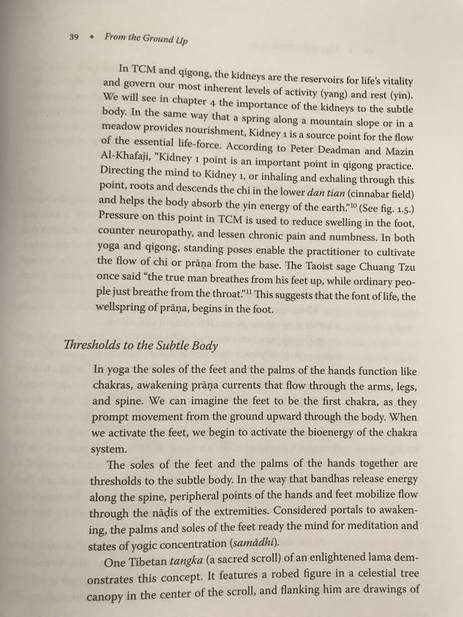
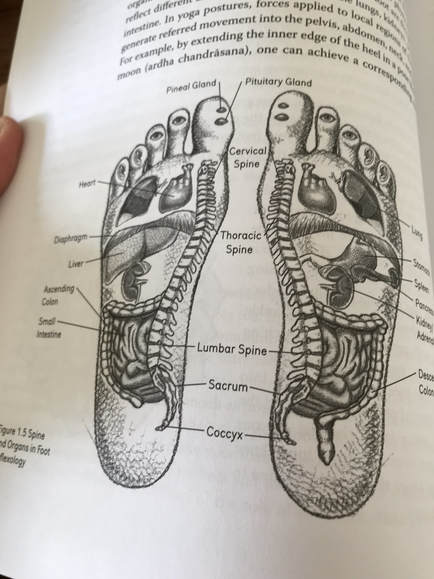
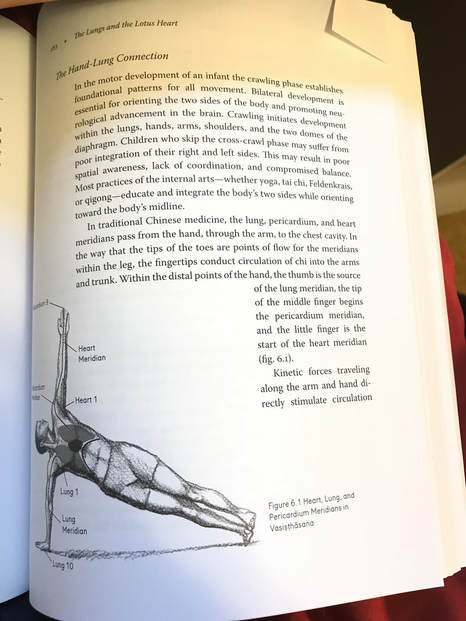
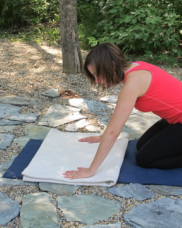
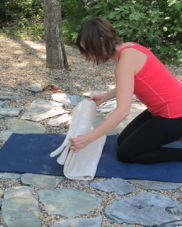
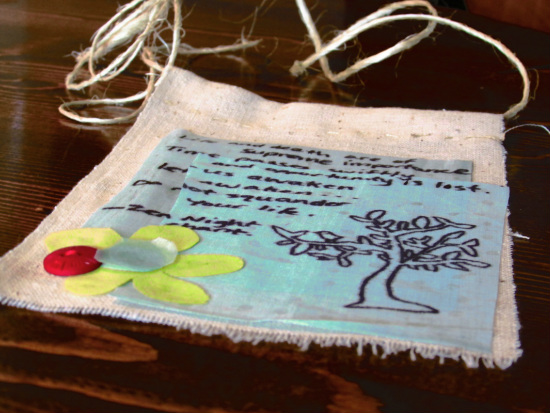
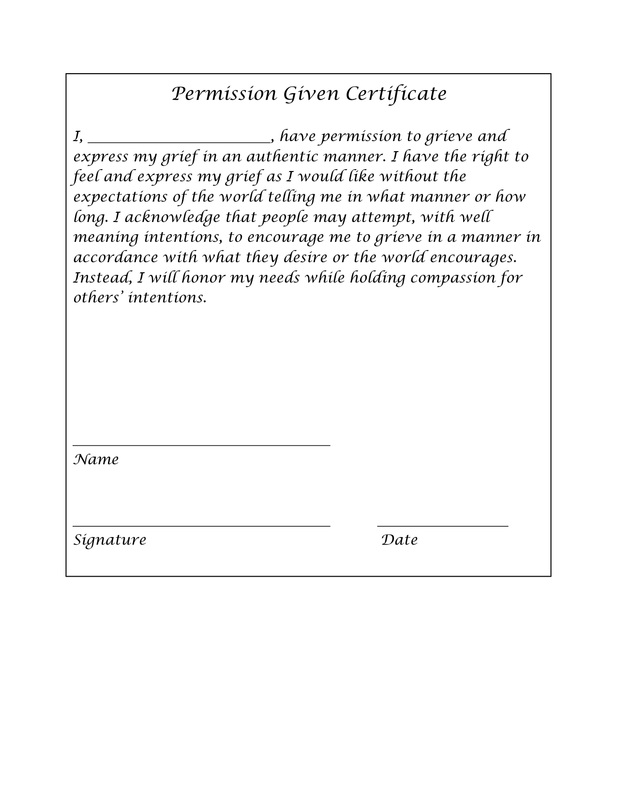
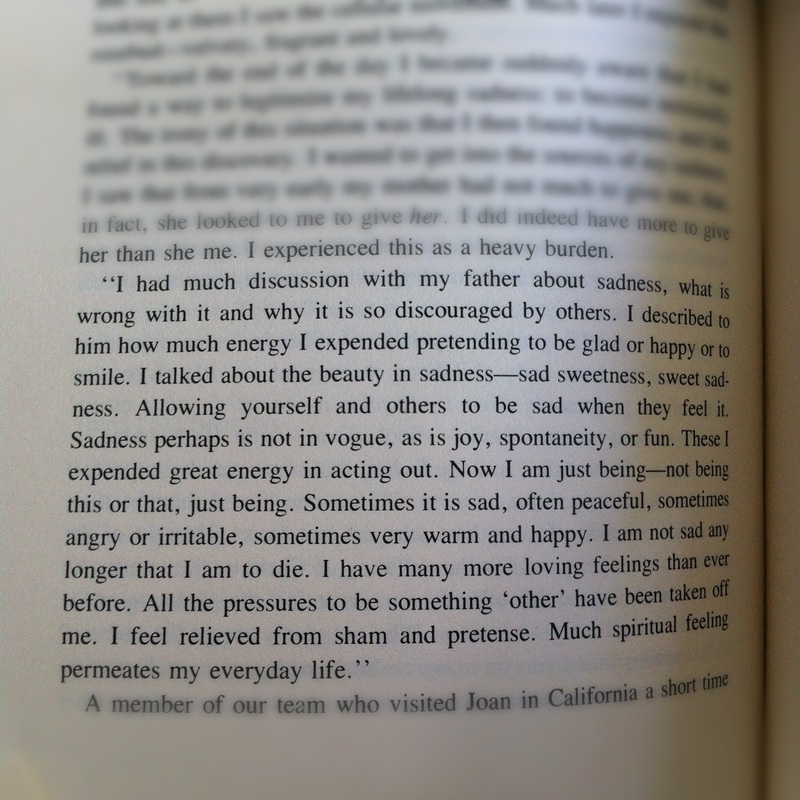
 RSS Feed
RSS Feed
